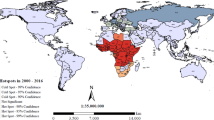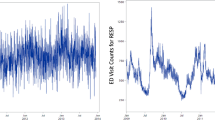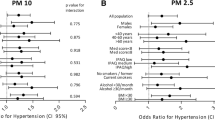Abstract
Fine particulate matter <2.5 μm (PM2.5) has been associated with human health issues; however, findings regarding the influence of PM2.5 on respiratory disease remain inconsistent. The short-term, population-based association between the respiratory clinic visits of children and PM2.5 exposure levels were investigated by considering both the spatiotemporal distributions of ambient pollution and clinic visit data. We applied a spatiotemporal structured additive regression model to examine the concentration–response (C–R) association between children’s respiratory clinic visits and PM2.5 concentrations. This analysis was separately performed on three respiratory disease categories that were selected from the Taiwanese National Health Insurance database, which includes 41 districts in the Taipei area of Taiwan from 2005 to 2007. The findings reveal a non-linear C–R pattern of PM2.5, particularly in acute respiratory infections. However, a PM2.5 increase at relatively lower levels can elevate the same-day respiratory health risks of both preschool children (<6 years old) and schoolchildren (6–14 years old). In preschool children, same-day health risks rise when concentrations increase from 0.76 to 7.44 μg/m3, and in schoolchildren, same-day health risks rise when concentrations increase from 0.76 to 7.52 μg/m3. Changes in PM2.5 levels generally exhibited no significant association with same-day respiratory risks, except in instances where PM2.5 levels are extremely high, and these occurrences do exhibit a significant positive influence on respiratory health that is especially notable in schoolchildren. A significant high relative rate of respiratory clinic visits are concentrated in highly populated areas. We highlight the non-linearity of the respiratory health effects of PM2.5 on children to investigate this population-based association. The C–R relationship in this study can provide a highly valuable alternative for assessing the effects of ambient air pollution on human health.
This is a preview of subscription content, access via your institution
Access options
Subscribe to this journal
Receive 6 print issues and online access
$259.00 per year
only $43.17 per issue
Buy this article
- Purchase on Springer Link
- Instant access to full article PDF
Prices may be subject to local taxes which are calculated during checkout






Similar content being viewed by others
References
Pope CA, 3rd, Burnett RT, Thun MJ, Calle EE, Krewski D, Ito K, et al. Lung cancer, cardiopulmonary mortality, and long-term exposure to fine particulate air pollution. JAMA 2002; 287: 1132–1141.
Dockery DW, Pope CA, 3rd, Xu X, Spengler JD, Ware JH, Fay ME, et al. An association between air pollution and mortality in six U.S. cities. N Engl J Med 1993; 329: 1753–1759.
Pope CA, 3rd, Dockery DW . Health effects of fine particulate air pollution: lines that connect. J Air Waste Manage Assoc 2006; 56: 709–742.
Dockery DW, Pope CA, III . Acute respiratory effects of particulate air pollution. Annu Rev Public Health 1994; 15: 107–132.
Schwartz J, Dockery DW, Neas LM, Wypij D, Ware JH, Spengler JD, et al. Acute effects of summer air pollution on respiratory symptom reporting in children. Am J Respir Crit Care Med 1994; 150: 1234–1242.
Laden F, Neas LM, Dockery DW, Schwartz J . Association of fine particulate matter from different sources with daily mortality in six U.S. cities. Environ Health Perspect 2000; 108: 941–947.
Franklin M, Zeka A, Schwartz J . Association between PM2.5 and all-cause and specific-cause mortality in 27 US communities. J Expos Sci Environ Epidemiol 2007; 17: 279–287.
USEPA Integrated Science Assessment for Particulate Matter (Final Report). US Environmental Protection Agency: Washington, DC, USA. 2009.
Zanobetti A, Schwartz J . Air pollution and emergency admissions in Boston, MA. J Epidemiol Commun Health 2006; 60: 890–895.
Winquist A, Klein M, Tolbert P, Flanders WD, Hess J, Sarnat SE . Comparison of emergency department and hospital admissions data for air pollution time-series studies. Environ Health 2012; 11: 70.
Zanobetti A, Franklin M, Koutrakis P, Schwartz J . Fine particulate air pollution and its components in association with cause-specific emergency admissions. Environ Health 2009; 8: 58.
Burnett RT, Smith-Doiron M, Stieb D, Cakmak S, Brook JR . Effects of particulate and gaseous air pollution on cardiorespiratory hospitalizations. Archiv Environ Health 1999; 54: 130–139.
Karr CJ, Rudra CB, Miller KA, Gould TR, Larson T, Sathyanarayana S, et al. Infant exposure to fine particulate matter and traffic and risk of hospitalization for RSV bronchiolitis in a region with lower ambient air pollution. Environ Res 2009; 109: 321–327.
Brauer M, Hoek G, Smit HA, de Jongste JC, Gerritsen J, Postma DS, et al. Air pollution and development of asthma, allergy and infections in a birth cohort. Eur Respir J 2007; 29: 879–888.
Katanoda K, Sobue T, Satoh H, Tajima K, Suzuki T, Nakatsuka H, et al. An association between long-term exposure to ambient air pollution and mortality from lung cancer and respiratory diseases in Japan. J Epidemiol/Jpn Epidemiol Assoc 2011; 21: 132–143.
Neupane B, Jerrett M, Burnett RT, Marrie T, Arain A, Loeb M . Long-term exposure to ambient air pollution and risk of hospitalization with community-acquired pneumonia in older adults. Am J Respir Crit Care Med 2010; 181: 47–53.
Ko FW, Tam W, Wong TW, Chan DP, Tung AH, Lai CK, et al. Temporal relationship between air pollutants and hospital admissions for chronic obstructive pulmonary disease in Hong Kong. Thorax 2007; 62: 780–785.
Kumar N, Liang D, Comellas A, Chu AD, Abrams T, Satellite-based PM . Satellite-based PM oncentrations and their application to COPD in Cleveland, OH. J Expos Sci Environ Epidemiol 2013; 23: 637–646.
Qiu H, Yu IT, Tian L, Wang X, Tse LA, Tam W, et al. Effects of coarse particulate matter on emergency hospital admissions for respiratory diseases: a time-series analysis in Hong Kong. Environ Health Perspect 2012; 120: 572–576.
Valdes A, Zanobetti A, Halonen JI, Cifuentes L, Morata D, Schwartz J . Elemental concentrations of ambient particles and cause specific mortality in Santiago, Chile: a time series study. Environ Health 2012; 11: 82.
Delfino RJ, Staimer N, Gillen D, Tjoa T, Sioutas C, Fung K, et al. Personal and ambient air pollution is associated with increased exhaled nitric oxide in children with asthma. Environ Health Perspect 2006; 114: 1736–1743.
Slaughter JC, Kim E, Sheppard L, Sullivan JH, Larson TV, Claiborn C . Association between particulate matter and emergency room visits, hospital admissions and mortality in Spokane, Washington. J Expos Anal Environ Epidemiol 2005; 15: 153–159.
Nachman KE, Parker JD . Exposures to fine particulate air pollution and respiratory outcomes in adults using two national datasets: a cross-sectional study. Environ Health 2012; 11: 25.
Schwartz J, Neas LM . Fine particles are more strongly associated than coarse particles with acute respiratory health effects in schoolchildren. Epidemiology 2000; 11: 6–10.
Dominici F, Peng RD, Bell ML, Pham L, McDermott A, Zeger SL, et al. Fine particulate air pollution and hospital admission for cardiovascular and respiratory diseases. JAMA 2006; 295: 1127–1134.
Bell ML, Ebisu K, Peng RD, Walker J, Samet JM, Zeger SL et al. Seasonal and regional short-term effects of fine particles on hospital admissions in 202 US counties, 1999-2005. Am J Epidemiol 2008; 168: 1301–1310.
Ostro B, Roth L, Malig B, Marty M . The effects of fine particle components on respiratory hospital admissions in children. Environ Health Perspect 2009; 117: 475–480.
Atkinson RW, Yu D, Armstrong BG, Pattenden S, Wilkinson P, Doherty RM, et al. Concentration-response function for ozone and daily mortality: results from five urban and five rural U.K. populations. Environ Health Perspect 2012; 120: 1411–1417.
Kim SY, Lee JT, Hong YC, Ahn KJ, Kim H . Determining the threshold effect of ozone on daily mortality: an analysis of ozone and mortality in Seoul, Korea, 1995-1999. Environ Res 2004; 94: 113–119.
Daniels MJ, Dominici F, Samet JM, Zeger SL . Estimating particulate matter–mortality dose–response curves and threshold levels: an analysis of daily time-series for the 20 largest US cities. Am J Epidemiol 2000; 152: 397–406.
Schwartz J, Laden F, Zanobetti A . The concentration–response relation between PM(2.5) and daily deaths. Environ Health Perspect 2002; 110: 1025–1029.
Samoli E, Schwartz J, Wojtyniak B, Touloumi G, Spix C, Balducci F, et al. Investigating regional differences in short-term effects of air pollution on daily mortality in the APHEA project: a sensitivity analysis for controlling long-term trends and seasonality. Environ Health Perspect 2001; 109: 349–353.
Dominici F, McDermott A, Zeger SL, Samet JM . On the use of generalized additive models in time-series studies of air pollution and health. Am J Epidemiol 2002; 156: 193–203.
Galan I, Tobias A, Banegas JR, Aranguez E . Short-term effects of air pollution on daily asthma emergency room admissions. Eur Resp J 2003; 22: 802–808.
Tenias JM, Ballester F, Perez-Hoyos S, Rivera ML . Air pollution and hospital emergency room admissions for chronic obstructive pulmonary disease in Valencia, Spain. Arch Environ health 2002; 57: 41–47.
Erbas B, Kelly AM, Physick B, Code C, Edwards M . Air pollution and childhood asthma emergency hospital admissions: estimating intra-city regional variations. Int J Environ Health Res 2005; 15: 11–20.
Farhat SC, Paulo RL, Shimoda TM, Conceicao GM, Lin CA, Braga AL, et al. Effect of air pollution on pediatric respiratory emergency room visits and hospital admissions. Braz J Med Biol Res 2005; 38 (2): 227–235.
Samoli E, Analitis A, Touloumi G, Schwartz J, Anderson HR, Sunyer J, et al. Estimating the exposure–response relationships between particulate matter and mortality within the APHEA multicity project. Environ Health Perspect 2005; 113: 88–95.
Pope CA, III . Particulate matter–mortality exposure–response relations and threshold. Am J Epidemiol 2000; 152: 407–412.
Li S, Batterman S, Wasilevich E, Wahl R, Wirth J, Su FC, et al. Association of daily asthma emergency department visits and hospital admissions with ambient air pollutants among the pediatric Medicaid population in Detroit: time-series and time-stratified case-crossover analyses with threshold effects. Environ Res 2011; 111: 1137–1147.
Englert N . Fine particles and human health – a review of epidemiological studies. Toxicol Lett 2004; 149: 235–242.
Dominici F, McDermott A, Zeger SL, Samet JM . National maps of the effects of particulate matter on mortality: exploring geographical variation. Environ Health Perspect 2003; 111: 39–44.
Dominici F, Daniels M, Zeger SL, Samet JM . Air pollution and mortality: estimating regional and national dose–response relationships. J Am Stat Assoc 2002; 97: 100–111.
Dominici F, Samet JM, Zeger SL . Combining evidence on air pollution and daily mortality from the 20 largest US cities: a hierarchical modelling strategy. J R Stat Soc 2000; 163: 263–302.
WHO Health Effects of Particulate Matter: Policy Implications for Countries in Eastern Europe, Caucasus and Central Asia. World Health Organization: Copenhagen, Denmark. 2013.
Chien L-C, Bangdiwala S . The implementation of Bayesian structural additive regression models in multi-city time series air pollution and human health studies. Stoch Environ Res Risk Assess 2012; 26: 1041–1051.
Tseng CH . Mortality and causes of death in a national sample of diabetic patients in Taiwan. Diabetes Care 2004; 27: 1605–1609.
Chang SC, Lee CT . Evaluation of the trend of air quality in Taipei, Taiwan from 1994 to 2003. Environ Monitor Assess 2007; 127: 87–96.
Tzeng GH, Tsaur SH, Laiw YD, Opricovic S . Multicriteria analysis of environmental quality in Taipei: public preferences and improvement strategies. J Environ Manage 2002; 65: 109–120.
Yu HL, Wang CH . Quantile-based Bayesian maximum entropy approach for spatiotemporal modeling of ambient air quality levels. Environ Sci Technol 2013; 47: 1416–1424.
Akaike H . A new look at the statistical model identification. IEEE Trans Automat Control 1974; 19: 716–723.
Lang S, Brezger A . Bayesian P-splines. J Comput Graph Statist 2004; 13: 183–212.
Kindermann R, Snell JL . Markov Random Fields and their Applications. American Mathematical Society: Providence, RI, USA. 1980.
Fromont A, Binquet C, Sauleau EA, Fournel I, Bellisario A, Adnet J, et al. Geographic variations of multiple sclerosis in France. Brain 2010; 133: 1889–1899.
Belitz C, Brezger A, Kneib T, Lang S., BayesX – Software for Bayesian Inference in Structured Additive Regression Models Version 2.1. http://www.BayesX.org/.
Host S, Larrieu S, Pascal L, Blanchard M, Declercq C, Fabre P, et al. Short-term associations between fine and coarse particles and hospital admissions for cardiorespiratory diseases in six French cities. Occup Environ Med 2008; 65: 544–551.
McClellan RO . Setting ambient air quality standards for particulate matter. Toxicology 2002; 181–182: 329–347.
Chien LC, Yang CH, Yu HL . Estimated effects of Asian dust storms on spatiotemporal distributions of clinic visits for respiratory diseases in Taipei children (Taiwan). Environ Health Perspect 2012; 120: 1215–1220.
Barnett AG, Williams GM, Schwartz J, Neller AH, Best TL, Petroeschevsky AL, et al. Air pollution and child respiratory health: a case-crossover study in Australia and New Zealand. Am J Resp Crit Care Med 2005; 171: 1272–1278.
Jimenez E, Linares C, Rodriguez LF, Bleda MJ, Diaz J . Short-term impact of particulate matter (PM2.5) on daily mortality among the over-75 age group in Madrid (Spain). Sci Total Environ 2009; 407: 5486–5492.
Hsu S-C, Liu SC, Lin C-Y, Hsu R-T, Huang Y-T, Chen Y-W . Metal compositions of PM10 and PM2. 5 aerosols in Taipei during spring, 2002. Terr Atmos Ocean Sci 2004; 15: 925–948.
Tsai YI, Chen C-L . Characterization of Asian dust storm and non-Asian dust storm PM 2.5 aerosol in southern Taiwan. Atmos Environ 2006; 40: 4734–4750.
Chou CC-K, Lin C-Y, Chen T-K, Hsu S-C, Lung S-C, Liu SC, et al. Influence of long-range transport dust particles on local air quality: a case study on Asian dust episodes in Taipei during the spring of 2002. Terr Atmos Ocean Sci 2004; 15: 881–889.
Yu HL, Yang CH, Chien LC . Spatial vulnerability under extreme events: a case of Asian dust storm's effects on children's respiratory health. Environ Int 2013; 54: 35–44.
Ouyang L . The geographical study of health care facility distribution in Taipei City, Taiwan. J Geogr Res 2006; 45: 51–72.
Acknowledgements
This work was supported by funds from Taiwan National Science Council (NSC 101-2628-E-002-017-MY3 and NSC 102-2221-E-002-140-MY3) and the Environmental Protection Department of the New Taipei City Government in Taiwan. The funders had no role in the study design, data collection, statistical analysis, decision to publish and manuscript preparation. We also appreciate Mrs. Mary Trottier’s help in the English editing of this manuscript.
Author information
Authors and Affiliations
Corresponding author
Ethics declarations
Competing interests
The authors declare no conflict of interest.
Additional information
Supplementary Information accompanies the paper on the Journal of Exposure Science and Environmental Epidemiology website
Supplementary information
Rights and permissions
About this article
Cite this article
Yu, HL., Chien, LC. Short-term population-based non-linear concentration–response associations between fine particulate matter and respiratory diseases in Taipei (Taiwan): a spatiotemporal analysis. J Expo Sci Environ Epidemiol 26, 197–206 (2016). https://doi.org/10.1038/jes.2015.21
Received:
Revised:
Accepted:
Published:
Issue Date:
DOI: https://doi.org/10.1038/jes.2015.21
Keywords
This article is cited by
-
Association between ambient air pollutants and upper respiratory tract infection and pneumonia disease burden in Thailand from 2000 to 2022: a high frequency ecological analysis
BMC Infectious Diseases (2023)
-
Impact of the critical episode management program on emergency room admissions for respiratory diseases in south-central Chile
Air Quality, Atmosphere & Health (2022)
-
Observed causative impact of fine particulate matter on acute upper respiratory disease: a comparative study in two typical cities in China
Environmental Science and Pollution Research (2022)
-
Short-term exposure to ambient air pollution and daily atherosclerotic heart disease mortality in a cool climate
Environmental Science and Pollution Research (2019)
-
Effect and threshold of PM2.5 on population mortality in a highly polluted area: a study on applicability of standards
Environmental Science and Pollution Research (2019)



